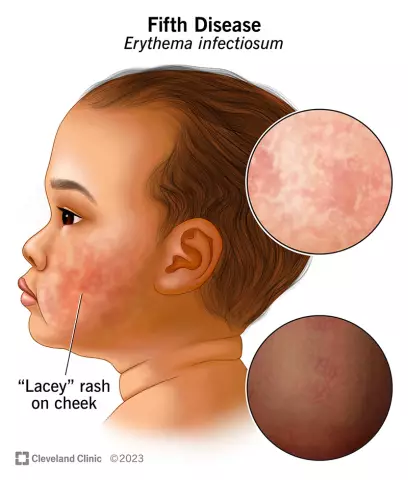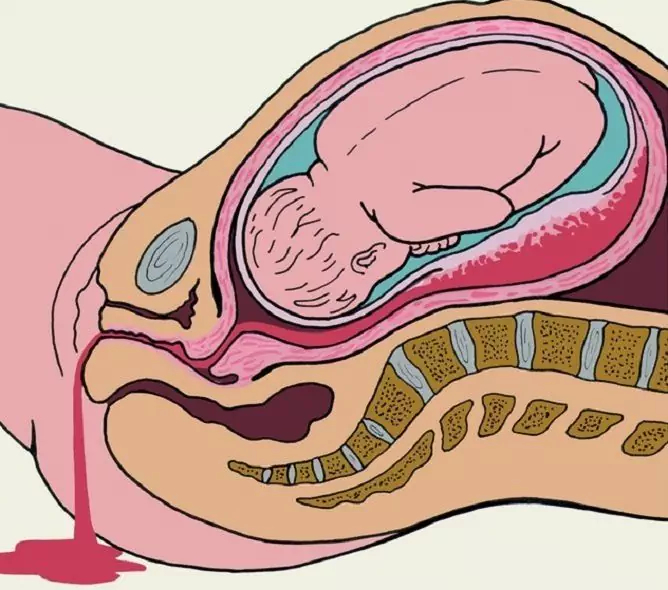- Author Rachel Wainwright [email protected].
- Public 2023-12-15 07:39.
- Last modified 2025-11-02 20:14.
Exudative erythema

Exudative erythema (multiforme) is one of the clinical manifestations of erythema, which is characterized by the formation of a polymorphic rash on the mucous membranes and skin. The disease tends to relapse (especially in the spring and fall) and is most common among middle-aged and young people.
The term "exudative erythema" is used to refer to a similar clinical rash that develops with certain infectious diseases or due to allergy to drugs. Thus, there are two main forms of exudative erythema:
- Idiopathic (infectious-allergic);
- Symptomatic (toxic-allergic).
Symptoms of exudative erythema
With idiopathic exudative erythema, the disease begins with prodromal phenomena (malaise, weakness, low-grade fever, sore throat, muscles, joints), developing against the background of angina, acute respiratory disease, hypothermia. The symptomatic form of the disease manifests itself mainly after taking certain medications (antibiotics, barbiturates, sulfa drugs, amidopyrine), the administration of vaccines and serums. In the future, the clinical picture of the disease of both forms does not differ.
Exudative erythema is characterized by a symmetrical lesion of the skin of the extensor surfaces (forearms, hands), face, neck, backs of feet, legs. Often, the oral mucosa is involved in the inflammatory process. The rash has the form of spots with a diameter of 3-15 mm, rounded with sharp borders of bright red color, differing in the retraction of the central part, resulting in a "ring within the ring". The spots are prone to merging with the formation of figures with polycyclic outlines (arcs, garlands, etc.). With exudative erythema, new rashes appear during the first days of the disease and are accompanied by headache, malaise, and fever. The duration of the inflammatory process, as a rule, is 10-15 days and ends with the patient's recovery.
Treatment of exudative erythema
In milder forms, the treatment of exudative erythema is mainly symptomatic, in which therapy is aimed at eliminating the main signs of the disease. At the same time, special ointments containing adrenal cortex hormones are applied to the areas of lesions. The mucous membrane of the mouth is cleaned with cotton swabs moistened with antiseptic solutions. In order to reduce painful sensations, lidocaine can be used.
In more severe cases, exudative erythema is treated with corticosteroid hormones (prednisone 40-60 mg / day). At the indicated dose, the drug is taken for 5-7 days, then every 2-3 days the dose is reduced by 5 mg until it is completely canceled. In the presence of a secondary infection, antibiotic therapy is used. When joining the disease of herpes infection, antiviral drugs are prescribed (remantadine, acyclovir 200 mg 3 times a day).

In case of necrotic plaque on the surface of the erosions that have appeared, applications of proteolytic enzymes (chymotrypsin, lysoamidases) are used, after which keratoplastic agents (sea buckthorn and rosehip oils, carotolin, solcoseryl, oil solutions of vitamins A, E are used to accelerate tissue epithelization).
One of the most severe forms of erythema exudative course is called Stevens-Johnson syndrome: it is characterized by high fever, severe pain in muscles and joints, bullous lesions of the mucous membranes of the nose, mouth, genitals. Often, the mucous membranes of the respiratory tract, esophagus, and stomach are involved in the pathological process.
If blisters appear on the skin surface, it is recommended to open them with sterile scissors. The prognosis for timely treatment of exudative erythema (except for Stevens-Johnson syndrome) is almost always favorable.
Prevention of exudative erythema
Prophylactic treatment of exudative erythema is carried out in the spring and autumn (several months before the expected relapse). For this purpose, measures are being taken to rehabilitate foci of chronic infection, prevent chills, and also general hardening of the body. Prophylactic drug treatment consists of taking:
- Levamisole (150 mg for 2 consecutive days, with an interval of 5 days);
- Ethacridine lactate (within 10-15 days, 0.05 g 3 times / day).
With the toxic-allergic form of exudative erythema, it is important not to allow the intake of the medication that provokes this disease.
YouTube video related to the article:
The information is generalized and provided for informational purposes only. At the first sign of illness, see your doctor. Self-medication is hazardous to health!






